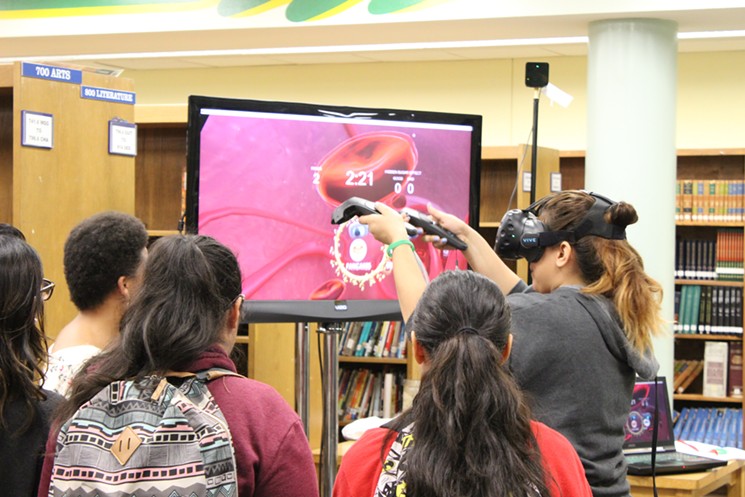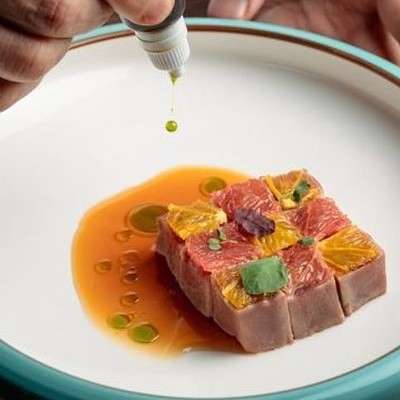The media has turned out in droves today. There are camera crews from NewsFix and Click 2 Houston. A photographer snaps pictures above kids’ heads, the sound like a large winged bug trapped in the library. We’re here to see something called Sugar Goggles, a virtual reality curriculum being developed by Healthcorps, a national health and wellness organization founded by Dr. Mehmet Oz, yes the Dr. Oz, and his wife Lisa in collaboration with the company Atkins Nutritionals —mostly known for its low carb diet program until creating said goggles— which these Sharpstown students will be testing out before it goes to more schools nationwide.
Healthcorps is sort of like the Peace Corps (or Teach For America) for public health workers. The organization provides high schools around the country with health coordinators who, for the most part, are fresh out of college and headed into jobs in the public health sector. At Sharpstown, that coordinator is Kenai McFadden, an energetic and well-spoken young man who is obviously well-loved among students. They all call him Mr. Mac.

Kenai McFadden is known as Mr. Mac and has been the driving force behind Sharpstown High's growing interest in health.
Photo by Gwendolyn Knapp
The curriculum today centers around sugar and its consequences. Mr. Mac has set up three different learning stations, where students will partake in games and discussions dealing with diabetes, sugar consumption and, of course, the virtual reality Sugar Goggles.
Since the sugar goggles station is overcrowded with too many adults and suits already, I decide to hang back with the students at the Understanding Diabetes role-playing station. Students here are learning how an estimated 52 percent of Americans now have some form of diabetes, and that one in four don’t even know they have it.
“Does anybody know any other complications that diabetes can cause?” a student in charge of the booth asks her audience. Blindness, a boy calls out. Amputation, another kid shouts.
“Death,” says a boy in a hat, who later introduces himself to me as a poet.
Four kids are asked to stand before the audience to act out diabetes, a veritable tableau of American overindulgence. Students are given the roles of Glucose, Insulin and Cell. We learn that in a healthy body, Insulin is a good date for Glucose and they’re both allowed to enter a party at the Cell’s house. But in type 1 diabetes, Insulin plays a crappy boyfriend, ditching Glucose before the party, where the Cell turns her away. And in type 2 diabetes, Insulin is more like a James Franco bad-influencer type, dragging Glucose to the party at the Cell’s, where they’re both turned away.
At the Think Before You Drink booth, students aren’t talking about alcohol, but about sugary drinks. Our student-instructor asks, “So who here tried the Unicorn Frappuccino at Starbucks last week?” I raise my hand meekly.
“So who here tried the Unicorn Frappuccino at Starbucks last week?”
tweet this
“How much sugar do you think is in that?” he asks me.
I am scared to answer. “I have no idea,” I say, fully shamed.
“It’s over 70 grams of sugar, so four times what you should have in a day. It would take four days with no sugar at all just for your body to recover and, like, function properly again.”
Volunteers from the audience are asked to arrange various bottles and cans of fruit juice, tea, sodas and water from the least saccharine to the most tooth-rottingly malevolent offenders. For some reason, no student is able to detect that a blue Mountain Dew is worse than a Coca-Cola.
The blue Dew comes in at a whopping 70+ grams of sugar in a serving. This is just a guess, but perhaps everything Unicorn-colored (pinks, blues, purples) is just diabetes juice. Large cans of AriZona tea are the most shocking offender, coming in right behind the blue Dew, as they’re supposed to contain three servings per can even though most people finish them in one sitting, meaning the sugar amounts to 70+ grams as well. That’s basically enough to cover a barbie doll in a Tony Montana-level of the white stuff. Sugar, these kids teach me, is 90 percent more addictive than cocaine.
Finally, I arrive at the Sugar Goggles station. There is a brief delay in gaming festivities as an anchor from NewsFix records his intro several times, holding the “goggles” up to the camera. The virtual reality program has been created by a team of highly regarded programmers out in Santa Barbara, who helped found “the Stanford Lab” (meaning the Virtual Human Interactional Lab), and created the program for Atkins in just two months’ time, the publicist tells me. “It’s not just a video game, but a way to incorporate curriculum that teaches them how to identify hidden sugars.” It’s sort of reminiscent of that old Back to the Future ride at Universal Studios where Marty flies inside of a dinosaur’s body, except we’re not riding in some simulated 4-D DeLorean in Orlando, Florida. We’re just standing around a screen in a high school library in Sharpstown.
A tall gal is selected from the crowd and crowned with the goggles, which are very RoboCop, and are accompanied by what looks like two car cup holders that she must hold in her hands while playing — on the screen these show up as skeletal, zombie-like hands that must reach out for the healthiest food choice as the gamer navigates her way through what looks like a sinewy world of muscle, blood and flying chocolate doughnut things. I ask the publicist what the flying chocolate doughnut things represent. Hemoglobin? Atomic matter? Sin?
“When the students make the healthy food choice, they’re propelled through the gold rings,” I am told.
There are also gold rings.
In essence, the game represents what happens to blood sugar levels when you choose to eat corn flakes over a cup of whole milk: BLOOD SUGAR!, a warning on the screen flashes as energy levels soar and crash. But the question remains: Do kids actually enjoy being harnessed into the RoboCop headpiece while waving the cumbersome zombie cup holders in the air just to learn if broccoli is a better snack than corn?
“It was fun,” a boy gushes for the CW cameras. “I learned how eating well keeps your blood sugar steady, but if you eat too much sugar you’ll have a spike and just slow down.”
Apparently, I'm the only one seeing chocolate doughnuts.
I am certain of one thing, though: There’s no way an educational virtual reality program has more effect on these young minds than the relationship they’ve cultivated with their Healthcorps coordinator, Mr. Mac. “You can’t say to a student, just go buy some quinoa,” he tells me. “But I can show them how if they walk across the street to La Michoacana, they can either make the choice to buy a bag of chips or to buy bananas to have for breakfast for the entire week.”
Mr. Mac offers a popular weekly after-school cooking class in the room, uses part of his budget to provide snacks for kids, has weened many of them off sodas and AriZona teas and just helped them throw a large and successful school health fair. He’s even inspired a few to want careers in health and nutrition.
The lunch bell rings and the kids gather around him, flinging rubber bracelets — free Healthcorps swag — in his direction.
“Is your room open?” a student asks him. The group wants to go eat and chill in his classroom as they always do.
“Always,” Mr. Mac says and smiles.
There’s just one rule: No unhealthy food allowed.











